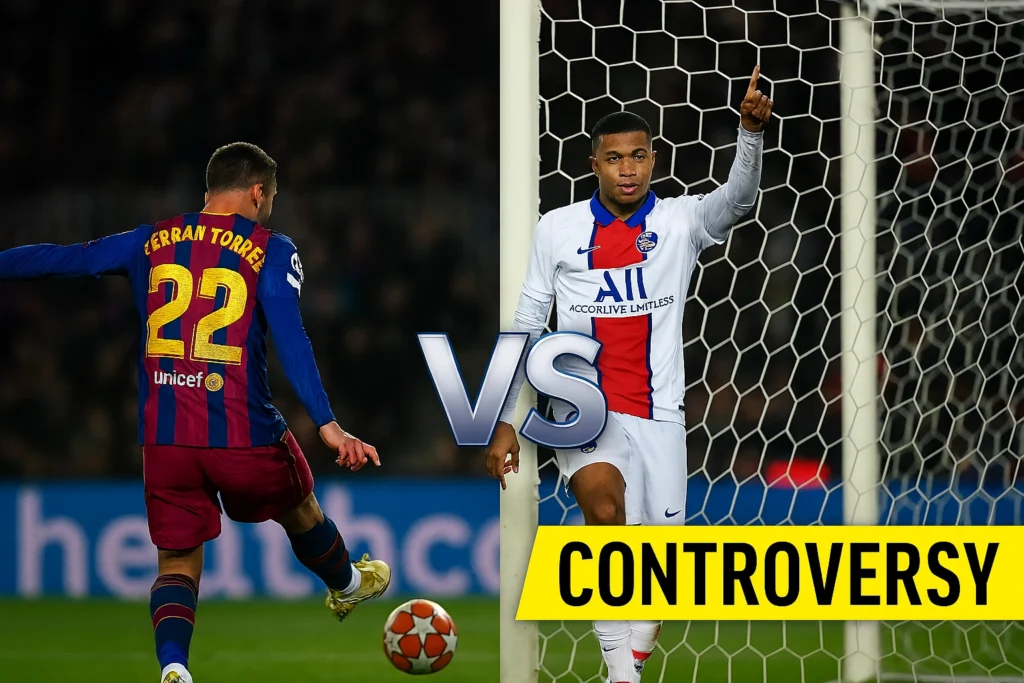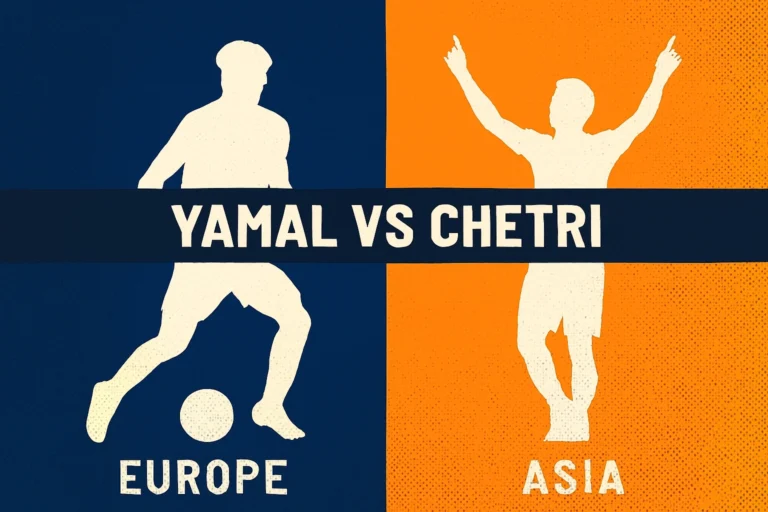Barcelona Vs PSG – The Ferran Torres Goal Controversy
In modern football, few things generate more heated debate than offside decisions. The recent clash between PSG and Barcelona at the 19-minute mark provided yet another talking point for fans, pundits, and analysts worldwide. Ferran Torres found the back of the net, but immediately, questions arose: was he offside? The answer, after careful analysis, is a resounding no – and understanding why requires a deep dive into one of football’s most misunderstood rules.

The Incident That Sparked the Debate
At exactly 19 minutes into the match, Barcelona orchestrated a swift attacking move that caught PSG’s defense off guard. Ferran Torres, positioning himself intelligently in the attacking third, received the ball and slotted it past the goalkeeper. The celebration was immediate, but so was the controversy. PSG players appealed frantically for offside, gesturing toward the linesman with the conviction that Torres had gained an unfair advantage.
However, the goal stood. The referee’s decision was clear, and replays would later vindicate this call. Torres was not offside, and the goal was legitimate. But why did it appear so controversial in real-time? The answer lies in understanding both the offside rule itself and the specific positioning of players during this crucial moment.
Understanding the Offside Rule
Before we can properly analyze why Torres’ goal was valid, we need to understand what offside actually means. The offside rule, governed by Law 11 of the Laws of the Game, states that a player is in an offside position if they are nearer to the opponent’s goal line than both the ball and the second-to-last opponent when the ball is played to them by a teammate.
This definition contains several critical elements that are often overlooked. First, a player must be in an offside position at the exact moment the ball is played to them – not when they receive it. This timing distinction is crucial and is often the source of confusion among fans watching in real-time. Second, the offside position is determined by the second-to-last opponent, which usually means the last defender plus the goalkeeper, though this can vary if the goalkeeper has moved upfield.
Additionally, being in an offside position is not an offense in itself. A player must be actively involved in play by interfering with an opponent, interfering with play, or gaining an advantage from being in that position. This nuance is what separates a technical offside position from an actual offside offense.
Why Ferran Torres Was NOT Offside
The critical moment came when the ball was played forward to Torres. At that precise instant, PSG’s defensive line made a fundamental error that would prove costly. Instead of maintaining a well-organized, compact defensive shape, there was a breakdown in communication that left one defender trailing significantly behind his teammates.
This trailing defender kept Torres onside. When analyzing offside decisions, we must look at the positioning of the second-to-last opponent at the moment the ball is played. In this case, while most of PSG’s defenders had pushed up in an attempted offside trap, one defender – whether through poor positioning, lack of awareness, or simply being caught off balance – remained deeper than his defensive partners.
Replays clearly showed that when the pass was made to Torres, this PSG defender was level with or behind the Barcelona forward. The offside rule doesn’t care about intentions or what the defensive line was trying to achieve; it cares only about the actual positions of players at the moment the ball is played. Torres, reading the game brilliantly, had timed his run perfectly to exploit this defensive lapse.
Furthermore, Torres’ body position was impeccable. Even his leading foot, which would be the part of his body closest to the goal line (and therefore the determining factor for offside), was behind the ball and the last defender when the pass was initiated. This is textbook attacking play – staying aware of the defensive line while timing your movement to perfection.
PSG’s Defensive Mistake
The real story here isn’t about a controversial refereeing decision; it’s about PSG’s defensive organization failure. The offside trap is a high-risk, high-reward tactical maneuver that requires perfect synchronization among all defenders. When executed correctly, it can neutralize even the most dangerous attacks. When it fails, it leaves attackers with clear paths to goal.
In this instance, PSG’s defenders attempted to step up as a unit to catch Torres offside. This is a common defensive tactic, particularly against teams like Barcelona who thrive on playing passes into space behind the defense. However, the execution was flawed. Whether it was a lack of communication, one defender anticipating the pass differently than his teammates, or simply a momentary lapse in concentration, the defensive line was not flat.
The trailing defender essentially played Torres onside. This is a mistake that professional defenders are taught to avoid from youth academies onwards. The offside trap requires absolute unity – if even one player is out of position, the entire tactic collapses. In modern football, where marginal gains can decide matches, such defensive errors are ruthlessly punished.
Additionally, PSG’s defensive midfielder may have failed to track back quickly enough, creating an additional layer of vulnerability. Even if the main defensive line had been better organized, having adequate midfield cover is essential when facing Barcelona’s quick transitions. The combination of poor defensive line management and insufficient midfield tracking created the perfect conditions for Torres to exploit.
The Technology Doesn’t Lie
In modern football, we have the benefit of semi-automated offside technology and VAR to assist referees in making these crucial decisions. These systems use multiple cameras and artificial intelligence to track player positions with millimeter precision. When Torres scored, the technology immediately analyzed the positions of every player on the pitch at the moment the ball was played.
The system confirmed what the referee and linesman had already decided: Torres was onside. The margin might have been small – these decisions often are – but it was definitive. There was no need for a lengthy VAR review because the on-field decision was correct, and the technology supported it.
This technological assistance has revolutionized how we understand offside decisions. In the past, we relied entirely on the naked eye of linesmen who had to simultaneously watch the passer, the runner, and the defensive line. Now, we have objective data that removes much of the controversy from these situations.
Why Fans and Players Were Confused
Despite the correctness of the decision, it’s understandable why there was initial confusion. From certain camera angles, particularly those from behind the goal or from the side where the main defensive line was positioned, it could appear that Torres was ahead of the defenders. The human eye, especially in real-time at match speed, often focuses on the majority of the defensive line rather than tracking every individual player.
PSG’s players genuinely believed they had caught Torres offside. This is a natural reaction – defenders are trained to appeal for offside, and in the heat of the moment, they likely didn’t register their teammate’s poor positioning. They saw most of their defensive line ahead of Torres and assumed the offside trap had worked.
Additionally, modern football moves at such incredible speed that even trained professionals can misread situations in real-time. The pass to Torres, his control, and his finish happened within seconds. In that compressed timeframe, making accurate judgments about relative positions is extremely challenging without the benefit of slow-motion replay.
The Importance of Understanding Offside
This incident serves as an important reminder of why understanding the offside rule matters. For players, knowing the exact moment when offside is determined can mean the difference between timing a run perfectly and being flagged. Attackers like Torres spend countless hours studying defensive behavior and learning to exploit the millisecond timing differences that separate legal goals from offside positions.
For defenders, the lesson is equally clear: defensive organization is paramount. A single player out of position can undermine an entire team’s tactical setup. PSG’s error wasn’t in attempting the offside trap. However, it’s a legitimate defensive tactic – but in failing to execute it with the required precision.
For fans, understanding these nuances enriches the viewing experience. Rather than simply reacting emotionally to decisions. Rather, we can appreciate the tactical chess match happening on the pitch and understand why referees make the calls they do.
Conclusion
Ferran Torres’ goal at the 19-minute mark against PSG was legitimate, properly awarded, and deserved. It wasn’t a case of controversial refereeing or technological failure – it was simply a well-timed run exploiting a defensive error. Torres was onside because PSG’s defensive line was not properly aligned. Moreover, with one defender keeping him in a legal position when the ball was played.
The offside rule, while complex, exists to balance attacking and defensive play. It prevents goal-hanging while still rewarding intelligent movement and precise timing. In this case, Barcelona executed their attack perfectly, while PSG made a critical defensive error. The referee and the technology both recognized this, and the goal correctly stood.
This incident should be studied in coaching sessions as a perfect example of why defensive organization matters and why attackers must master the timing of their runs. It demonstrates that in modern football’s margins of error, even the smallest positional mistake can be punished. For Torres, it was another goal to add to his tally. For PSG, it was a painful lesson in the importance of defensive unity and concentration throughout the entire match.
The controversy may rage on in fan forums and social media debates, but the facts are clear:. It was a goal, it was legal, and it highlighted the beautiful complexity of football’s most debated rule.


